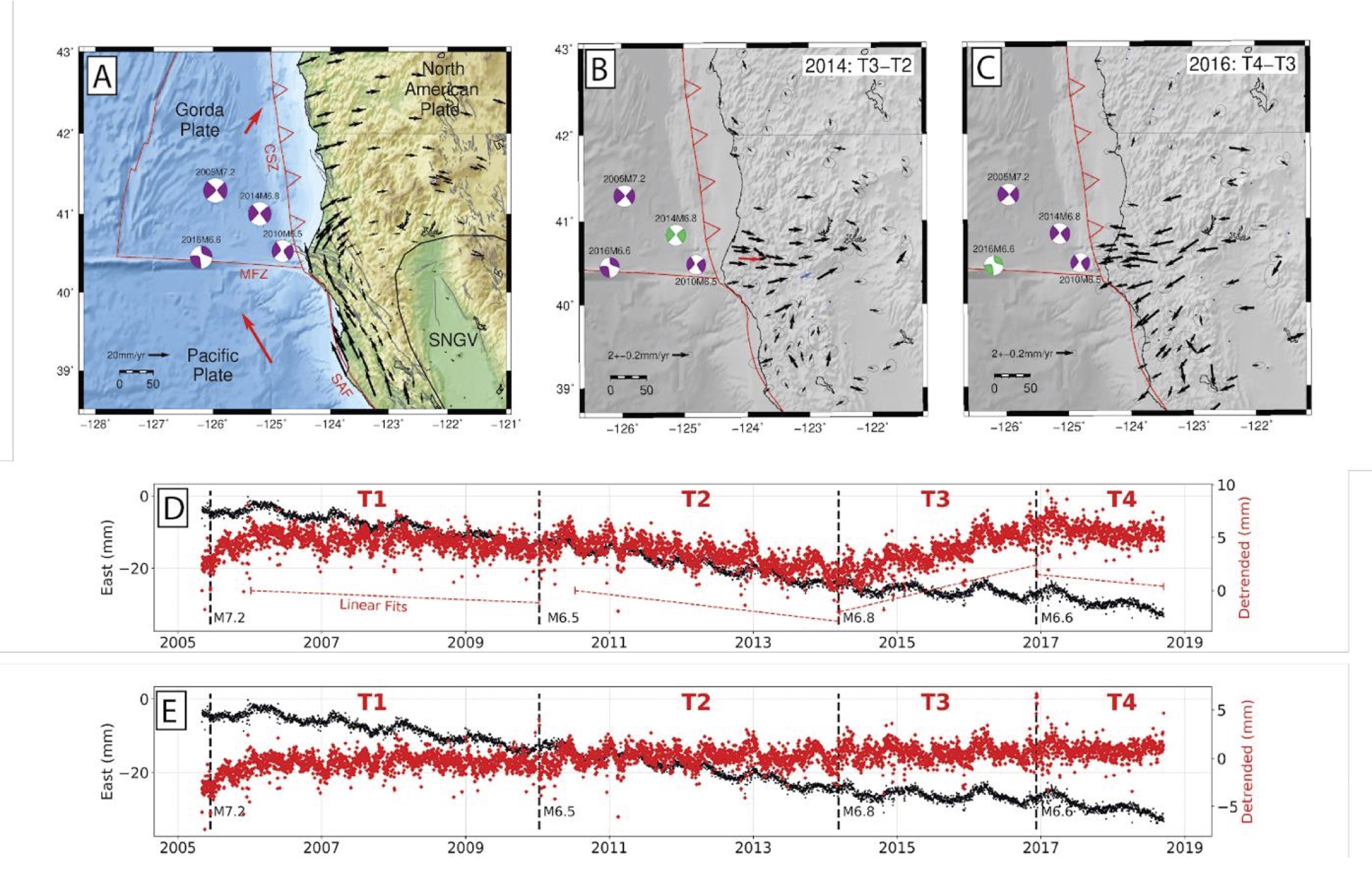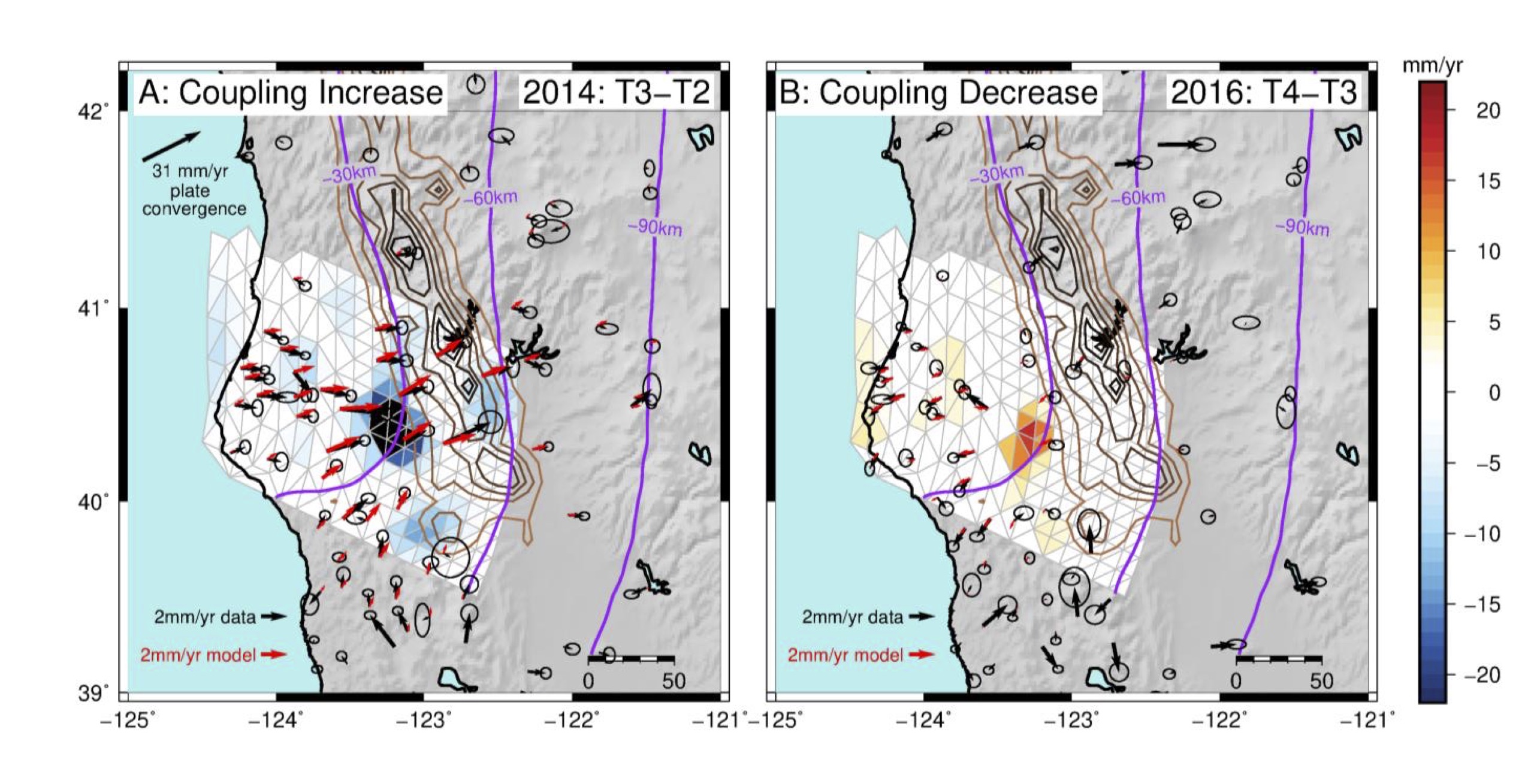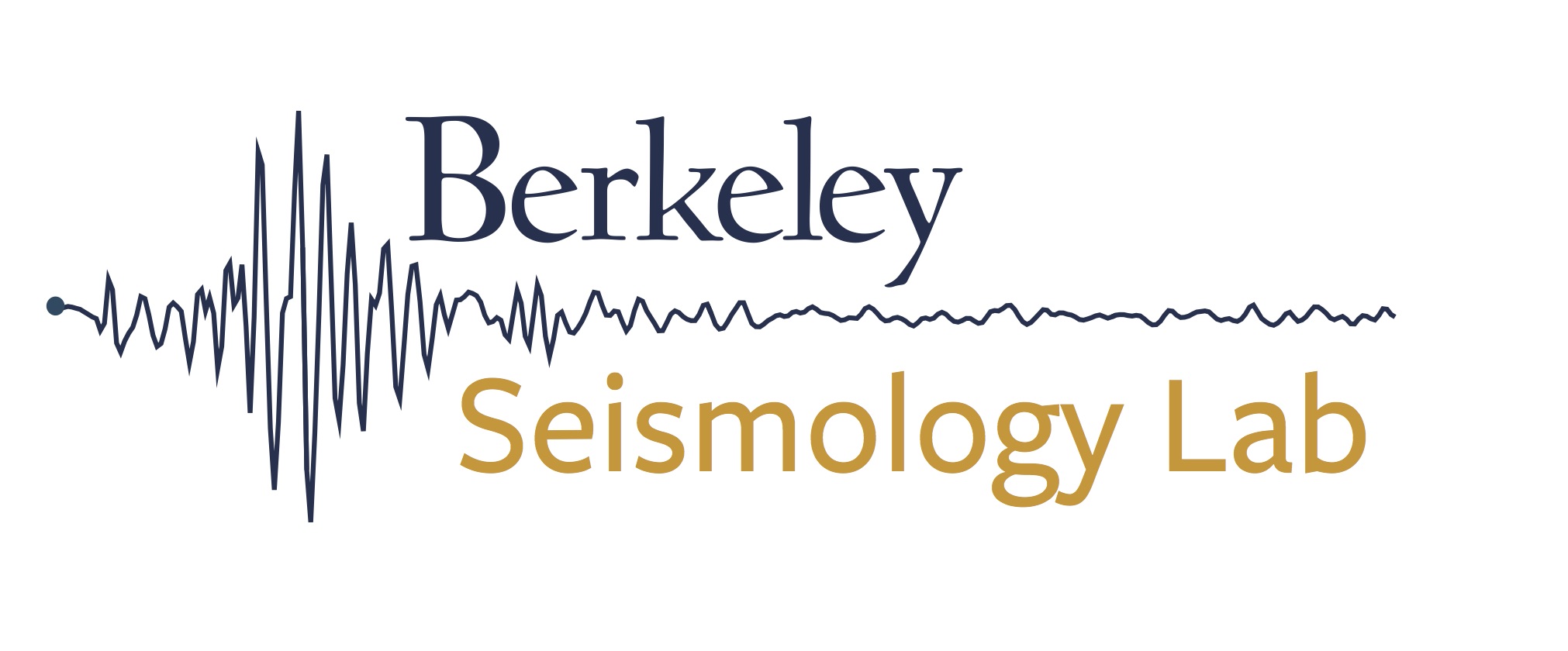Dynamically Triggered Changes of Plate Interface Coupling in Southern Cascadia
Kathryn Materna, UC Berkeley Ph.D. work
Publications:
Materna, K.*, N. M. Bartlow, A. Wech, C. Williams,and R. Bürgmann (in revision). Dynamically Triggered Changes of Plate Interface Coupling in Southern Cascadia, Geophys. Res. Lett.
In subduction zones, frictional locking on the subduction interface produces year-by-year surface deformation that is measurable with GPS. During the interseismic period of the earthquake cycle, lasting hundreds of years between major earthquakes, these ground motions are usually constant with time because the locking on the plate interface is relatively unchanging. However, at the Mendocino Triple Junction in Northern California, we find evidence for slight changes in GPS interseismic motion within the last decade that challenge the assumption of constant interseismic deformation. Our results suggest changes in interseismic coupling on the southernmost Cascadia Subduction Zone. Interestingly, these coupling changes appear to be related to large offshore earthquakes and are perhaps triggered by the seismic shaking during those events. These results have important implications for our understanding of seismic hazard in subduction zones.
 Figure 1: a) Tectonic setting of the Mendocino Triple Junction, located at the intersection of the San Andreas Fault (SAF), the Mendocino Fault Zone (MFZ), and the Cascadia Subduction Zone(CSZ). The black velocity vectors show the PBO velocity field in the Sierra Nevada Great Valley
(SNGV) reference frame, converted using the Euler Pole from Dixon et al. (2000). b and c)
Velocity changes (T3-T2 and T4-T3) from the PBO solutions with least-squares seasonal removal, shown with 1-sigma confidence ellipses. (d) Time series of east component for station
P160 (red arrow in (b)). Time series after removal of coseismic offsets is shown in black and the
detrended and de-seasonalized east component is shown in red, with dashed lines indicating the
periods used for slope estimation. e) Residuals to linear fits in Figure 1d.
Figure 1: a) Tectonic setting of the Mendocino Triple Junction, located at the intersection of the San Andreas Fault (SAF), the Mendocino Fault Zone (MFZ), and the Cascadia Subduction Zone(CSZ). The black velocity vectors show the PBO velocity field in the Sierra Nevada Great Valley
(SNGV) reference frame, converted using the Euler Pole from Dixon et al. (2000). b and c)
Velocity changes (T3-T2 and T4-T3) from the PBO solutions with least-squares seasonal removal, shown with 1-sigma confidence ellipses. (d) Time series of east component for station
P160 (red arrow in (b)). Time series after removal of coseismic offsets is shown in black and the
detrended and de-seasonalized east component is shown in red, with dashed lines indicating the
periods used for slope estimation. e) Residuals to linear fits in Figure 1d.
 Figure 2: Inversion results for the PBO GNSS velocity changes in 2014 and 2016, using a
correction for ETS events, the NLDAS model to correct for seasonal variation in the time series,
and elastic Green’s functions computed for a heterogeneous elastic earth structure. The brown
contours represent tremor density from the modified PNSN catalog, ranging from 0 to 2000
tremor epicenters per 10 x 10 km grid cell. The purple lines show the depth contours of the
interface geometry. The most prominent feature is a localized coupling change on the interface
around 40.3°N in both inversions.
Figure 2: Inversion results for the PBO GNSS velocity changes in 2014 and 2016, using a
correction for ETS events, the NLDAS model to correct for seasonal variation in the time series,
and elastic Green’s functions computed for a heterogeneous elastic earth structure. The brown
contours represent tremor density from the modified PNSN catalog, ranging from 0 to 2000
tremor epicenters per 10 x 10 km grid cell. The purple lines show the depth contours of the
interface geometry. The most prominent feature is a localized coupling change on the interface
around 40.3°N in both inversions. In Southern Cascadia, precise GNSS measurements spanning about 15 years reveal steady deformation due to locking on the Cascadia megathrust punctuated by transient deformation from large earthquakes and episodic tremor and slip events. Near the Mendocino Triple Junction, however, we recognize several abrupt GNSS velocity changes that reflect a different process. After correcting for earthquakes and seasonal loading, we find that several dozen GNSS time series show spatially coherent east-west velocity changes of about 2 mm/yr, and that these changes coincide in time with regional M>6.5 earthquakes. We consider several hypotheses and propose that dynamically triggered changes in megathrust coupling best explain the data. Our inversions locate the coupling changes slightly updip of the tremor-producing zone. We speculate that dynamic shaking near the tremor region may provide a mechanism. Observations of transient coupling changes are rare and challenging to explain mechanistically but have important implications for earthquake processes on faults.
